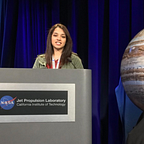Space News Recap | May 14-21
Solar System
Kuiper Belt
Astronomers have discovered that a large body beyond Neptune, in the Kuiper Belt, now has a moon. This body, called 2007 OR10, is one of the six bodies that are likely to be confirmed as dwarf planets, bringing the total count to eleven.
Out of eleven, only Ceres and Sedna do not have any moons (yet).
Jupiter
Juno flew by Jupiter’s cloudtops for the sixth time at barely 3,500 km above the planet. New pictures from this fly-by are expected to be released in two days.
Saturn
Cassini’s latest images of Saturn show the planet’s shadow shrinking over the rings as Saturn’s May 2017 solstice as the Sun reaches Saturn’s most northerly part in its 30 year orbit.
Celestial Events
North America is currently in the middle of a total solar eclipse nicknamed The Great American Solar Eclipse.
Launches
SpaceX launched its heaviest satellite so far, and did not attempt recovery due to the weight. Elon Musk’s space company used a Falcon 9 rocket to launch the 6,000 kilogram Inmarsat-5 F4 satellite into orbit. It is bigger than a double-decker bus and required SpaceX to increase the capacity of its Falcon 9 rocket.
Galactic News
Tabby’s Star, aka the Alien Megastructures star is finally dimming in brightness. This means that whatever is causing to come between us and the star is currently in position and we might be able to solve the mystery very soon!
People
Eighteen year old Karur student Rifath Shaarook and his team of six have built a cubesat touted to be the world’s lightest satellite. He has named it Kalamsat after our beloved president and astrophysicist APJ Abdul Kalam. The satellite that weighs just 64 grams was among 80 models selected among 86,000 designs submitted by young contestants belonging to 57 countries in the “Cubes in Space” contest organised by Idoodle Learning. The satellite is the only model selected from India to be launched into the sub-orbital space by SR 4 rocket.
